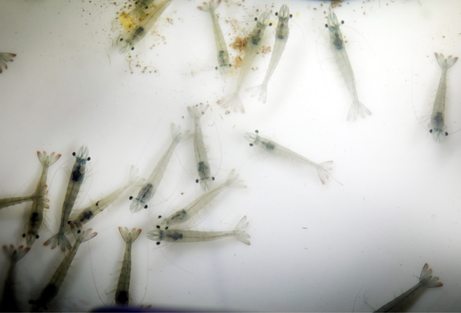Impact success story: Aquaculture
Can we protect the ecosystem in the North Sea and at the same time make more room to aquaculture? Can artificial oyster reefs break waves so that we no longer have to spray sand to preserve our coasts? Scientists from the blue growth research groups at Ghent University are looking for an answer to these questions.
On its campus in Ostend, the university has been investing in labs and staff via Greenbridge NV. The university has also teamed up with the port and the province of West Flanders to create Ostend Science Park that will serve as a truly blue science park. The university’s goal is to bring several areas of expertise to work together, so that what’s ‘good for the ecosystem’ also rhymes with what’s ‘good for the economy’.
Health of farmed fish and shrimp

This sector has grown enormously in recent years. Thirty years ago it accounted for barely 10%, but today more than half of our consumption comes from aquaculture. And it should continue to grow with the rise in the world population.
In Europe we import 70 to 80% from Asia, but the middle class there is growing and consuming more, which means that prices are rising. “As a result, we can already see that a number of retailers are also considering producing locally, but the high wage costs in Europe make it difficult to turn a profit. That is why there is a strong focus on automation. This is one of the knowledge leaps that we have to make in Europe over the next 5 years to remain competitive.”
Read more: no prawns or scampi without Ghent University
But is aquaculture possible in the North Sea?
Our sea is heavily navigated, we generate energy there with windmills and we also want to preserve a thriving ecosystem. In addition, the conditions in the North Sea are very tough and a large part of our waters is not deep enough for fish farming. Shellfish and seaweed farming is possible. So we are faced with a major challenge, but this doesn’t scare Margriet: “Maintaining a good ecosystem in the North Sea doesn’t mean that you cannot cultivate anything there. If you’re creative, you can combine many different activities.
All in all we have a small stretch of sea, but if you can do it in these conditions, you can do it anywhere. Our sea is actually our test room where we demonstrate our technology.
At the same time, we want to preserve a functioning ecosystem. This is also embedded in the Marine Spatial Plan which outlines which activities can be carried out in which part of the sea: nature preserve, military use, energy at sea, passive fishing, passage for ships, ... This has made us a global leader. The Norwegians, for example, are very interested in testing their technology here. It’s a quality label. If it works with us, it can work anywhere.”